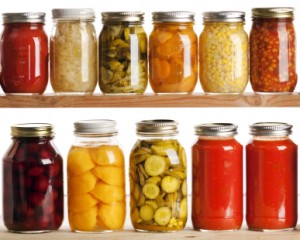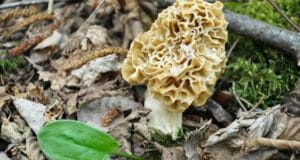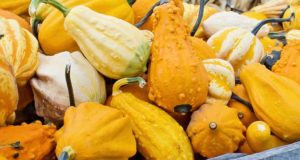 The acidity of a vegetable determines whether is should be processed in a water bath canner or a pressure canner. Low-acid vegetables (in fact, any low-acid food) do not contain sufficient acidity to destroy Clostridium botulinum bacteria, the bacteria responsible for botulism. This illness is a rare, but serious, paralytic condition caused by the toxins the botulinum bacteria produce under anaerobic conditions, or where air is not present, so even if your jars are sealed as tight as Fort Knox, if you haven’t raised the temperature of the contents sufficiently to kill the botulism spores present, you’re still gambling with the health and lives of yourself and your family. (Botulism is found in the soil all around you. The spores are akin to seeds, dormant, just waiting for the right conditions to grow. No matter how sanitary you are, botulism is present on most fresh food surfaces. Because they only grow in the absence of oxygen, they’re harmless on the surface of such foods.)
The acidity of a vegetable determines whether is should be processed in a water bath canner or a pressure canner. Low-acid vegetables (in fact, any low-acid food) do not contain sufficient acidity to destroy Clostridium botulinum bacteria, the bacteria responsible for botulism. This illness is a rare, but serious, paralytic condition caused by the toxins the botulinum bacteria produce under anaerobic conditions, or where air is not present, so even if your jars are sealed as tight as Fort Knox, if you haven’t raised the temperature of the contents sufficiently to kill the botulism spores present, you’re still gambling with the health and lives of yourself and your family. (Botulism is found in the soil all around you. The spores are akin to seeds, dormant, just waiting for the right conditions to grow. No matter how sanitary you are, botulism is present on most fresh food surfaces. Because they only grow in the absence of oxygen, they’re harmless on the surface of such foods.)
The spores are destroyed when food is cooked to temperatures of 250ºF for three minutes. However, home canners only raise the temperatures to around 240ºF. It’s possible to kill the spores at this lower temperature, but the food must be exposed to that lower temperature for a longer period of time to destroy the spores. It is impossible for water bath canners to reach these temperatures at all.
So Where Do We Start?
We start with the basics that you learned in the first article on pressure canning techniques—Canning 201. First, a word of caution, however. If you have a flat top ceramic stove, please contact the manufacturer to see if your stove surface can handle the canning process. Because canners are so big, they naturally extend beyond the burner surface itself. The glass outside the burner area is usually not tempered enough to withstand the heat that is generated during the canning process. You risk damage to your stove surface. Instead, use a sturdy electric portable single burner countertop model, or use a propane burner such as you may have with a catfish cooker or other exterior appliance. A Crisis Cooker is also an excellent choice as it adapts to different fuels—wood, charcoal, or propane. For canning purposes however, you’ll want to stick with the propane option.
Compared to water bath canning, you’ll need sufficiently more headroom in your jars—approximately 1 to 1¼ inches. This allows for expansion as the food processes, and allows for the formation of a vacuum as the jar cools. How much your food will expand depends on how much air is present. Raw-packing introduces more air into the jar, and your food may discolor somewhat after two or three months (this is cosmetic only). Hot packing helps remove the air from food and improves the shelf-life of your canned goods. However, hot-packing is a little more time consuming. Because my time is limited, I usually choose to raw-pack when I can, and I’ve had no problem with the shelf-life of my goods. The color of my veggies may not be magazine perfect, but they eat just as well!
Venting your pressure canner before sealing it with your weighted gauge or the counter-weight (if using a dial gauge) is vitally important. Raw-packed foods are especially notorious for introducing the highest amount of trapped air in canners. This trapped air lowers the temperature obtained when the canner is pressurized, resulting in under-processed foods that can spoil. All canners MUST be vented (and by vented we mean a heavy, almost whistling, steady flow of steam, not a wispy little vapor every once in a while) before being pressurized.
The Green Bean
Perhaps the easiest of the low-acid foods to can, green beans can be canned either raw- or hot-packed. Hot-packed will introduce less air into the canning process, so the following is the recipe for that process.
1) Assemble your jars, lids, screw bands, and utensils. Wash your jars in hot soapy water and rinse well. Keep them in hot water so that there’s not a temperature shock when placing them in the canner. You don’t have to sterilize jars used in a pressure canner. Place your lids and screw bands in a pot of simmering hot water (about 180ºF), but don’t allow them to boil. Boiling will break down the rubber seal.
2) Get your canner ready. Put two to three inches of water and maintain a simmering water temperature (again, about 180ºF) until all the jars are filled and placed in the canner.
3) Choose beans that are fresh, young, free of blemishes, and crisp. Wash them thoroughly in water, and then trim them to remove the strings. Cut or break them into similar-sized pieces.
4) Take your prepared green beans, cover them with water, and boil them for 5 minutes. Remove them from the heat.
5) With a slotted ladle, spoon your hot beans into the jars, adding 1 tsp. of salt per quart of ½ tsp per pint if desired. Once filled, pour your hot cooking water over the beans, leaving 1 inch of headspace.
6) Using your jar spatula, run it around the inside edges of the jar several times, manipulating the beans to remove trapped air bubbles.
7) Check the rim for any nicks or cracks that would cause a seal failure, wipe clean with a warm, wet rag, and place the lid on the jar. Tighten the screw band finger tight. Place the jar in your canner. Repeat with each jar.
8) Cover the pressure canner, adjust the heat, and vent for 10 minutes. Place the weighted gauge or pressure regulator over the vent pipe and bring the pressure up to 10 lbs. Adjust poundage for those altitudes higher than 1,000 feet above sea level if using a weighted gauge canner (2,000 feet if using a dial gauge) according to the chart below. Processing times are still the same.
ALTITUDE CHART FOR CANNING VEGETABLES
| ALTITUDE | DIAL GAUGE CANNER Pints and Quarts |
WEIGHTED GAUGE CANNER |
| 1,001 – 2,000 ft. | 11 lbs. | 15 lbs. |
| 2,001 – 4,000 ft. | 12 lbs. | 15 lbs. |
| 4,001 – 6,000 ft. | 13 lbs. | 15 lbs. |
| 6,001 – 8,000 ft. | 14 lbs. | 15 lbs. |
9) Process pints for 20 minutes and quarts for 25 minutes. If using mature beans that were almost at the “shell-out” stage, add an additional 15 minutes to pints and 20 minutes for quarts.
10) Turn off the heat to the canner and allow it to cool and depressurize naturally. Do not force the canner to depressurize. After the canner has reached zero pressure, open the vent and move the lid. Allow the jars to sit in the canner another 5 or 10 minutes to adjust to the lower temperatures.
11) Using your jar tongs, remove the jars from the canner, keeping them in an upright position so as not to disturb the lid. Place on several layers of towels so as to avoid temperature shock from a cool countertop. All the jars to cool for 12 to 24 hours. Check the seal by gently tugging on the lip of the lid and pressing down in the center of the lid. If the center of the lid is countersunk and you can’t move the lid with gentle tugs on the edge, your jar is sealed. Remove the bands, wipe the jars down, label, and store in a cool, dry place. Any jars that did not seal can either be reprocessed for the full amount of time or put into the refrigerator and eaten immediately.
One thing to remember, when canning multiple vegetables together, is to use the processing time for the longest cooking food. So if you’re processing five quart jars of beans (25 minutes) and 2 quart jars of black-eyed peas (40 minutes) you would process the canner load for 40 minutes. Use this formula when mixing vegetables in the same jar as well. For example, if you like to have potatoes in your green beans, then you would process a quart jar of the two mixed for 40 minutes, the length of time it takes to process potatoes.
Once you become familiar with your canner and the canning process, and begin to feel more comfortable with what you’re doing, you’ll want to begin to experiment with many different combinations and foods. Just remember, avoid recipes with dairy, flour, or rice in them. This includes noodles. These ingredients are too dense for home canners to thoroughly heat through, and again, without sustained temperatures of 240ºF, you risk illness and possibly death from botulism.
Coming up next week—Canning 203: Meats
 Off The Grid News Better Ideas For Off The Grid Living
Off The Grid News Better Ideas For Off The Grid Living



